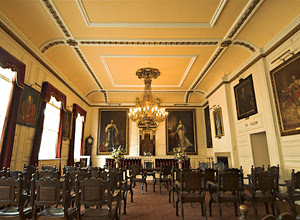And so Hubby and I arrived at the end of our journey. We decided to have our last English meal at the Three Tuns, another of the historic pubs of Windsor that happens to be located directly behind the Guildhall. I wanted my last meal of bangers of mash. And enough rum to drown my sorrows.
“Are you sad about going home tomorrow?” Hubby asked once we were seated.
“I’m home now. I’m sad about going back to Florida.”
“Most people in England would love to trade places with you,” Hubby commented.
“Mad dogs and Englishmen,” I replied.
“Huh?”
“Only mad dogs and Englishmen go out in the midday sun,” I said, referring to our sub tropic Florida weather. Humid doesn’t begin to cover it. I expect that Gunga Din and Wellington felt the same about India.
“The grass is always greener,” Hubby went on.
“How droll. Actually, the grass does happen to be greener in England, where it isn’t scorched by the blazing midday sun on a constant basis.”
“Droll?”
I gave Hubby a scathing look and he dropped it. “What time do we leave tomorrow?” he asked instead.
Oh boy. Here we go. “About tomorrow . . . . “
Now it was Hubby’s turn to glare. “C’mon, out with it.”
I ordered another round from a passing waiter and forged ahead. “After we fly into Newark, we have a four hour layover before our three hour flight to Florida.”
“What?”
“Ssshhhh! Don’t get excited.”
“Excited? Is that what you think I am? Excited? Because I’m telling you right now, excited I’m not. Why would you do that to me?”
“It was either that or wait till the next day to fly home.”
“For Christ’s sake, why didn’t you wait till the next day?”
“I didn’t know which option to choose and then I decided that you’d have blown a fuse no matter which way I went, so I opted for the layover. But it’s okay because Brooke is going to come to the airport to pick us up. We’ll all go out to eat, then we’ll go back to her house for a while and then she’ll bring us back to the airport. So we won’t be stuck at the terminal for four hours.”
This mollified him a bit. A very little bit.
“Listen, the next time you plan a trip to England for us, do it in the summer, will ya? And don’t include London on the itinerary. London is too crazy for me. I liked Bath and I like Windsor. Think small. And when you come over here to look for houses, you’re coming by yourself. I’m not traipsing all over England looking at houses. Understand?”
I kept my counsel, wisely deciding that now was not the time to tell Hubby that when a man was tired of London, he was tired of life.
“Alright, then, I’ll just bring Vicky with me.”
“And that’s another thing,” Hubby went on. “Don’t think I haven’t noticed that Ed and I don’t figure in the plans that you and Vicky have for living in England. I’m just hoping you two plan on letting us die natural deaths first.”
“Ideally you and Ed would be dead, granted, but I’ve got everything planned out in case you’re still alive when I move here.”
“Oh, brother. Go on. I can’t wait to hear this.”
“When we move to England, you’re going to raise chickens.”
“What?”
“I’ll take care of the sheep and you’ll raise chickens.”
“Are you nuts? Why would I raise chickens?”
“So that you can barter the eggs, of course. Just think about it, you’ll put on your tweed coat and make your way out every day to collect the eggs. Then you’ll take your basket and you’ll toddle your way down to the pub and trade your eggs for pints of beer. `Here are six fresh eggs in exchange for a pint of your best, my good man.’ I can hear you now.”
“It’s the twenty-first century. No one barters any more.”
“They do in England.”
“You’re nuts. You do realize that, don’t you? Explain to me why I wouldn’t just get in the car, drive to the pub and pay money for a pint of beer. You know, the way normal people do.”
“See, this is why you don’t figure into my plans for living in England. If I asked Vicky to collect the eggs and trade them in at the pub, she’d do it without an argument.”
“Because she’s as nuts as you are, that’s why. You’ll be known as the two crazy American women.”
“Widows.”
“Huh?”
“We’ll be known as the two crazy American widows.”
“Listen, all joking aside, dead or alive, I am not raising chickens. Got it?”
Our dinners arrived and we ate silently for a while. Then I asked, “Did you enjoy anything at all about the trip?”
Hubby looked at me. “Sure. Sure I did, Hon. I enjoyed all the parts that weren’t London, that didn’t involve walking, or rain or being sick.”
As near as I could figure, that left the plane ride over. And Burger and Lobster. And Café Nero.
“I wish you loved England as much as I do.”
“I don’t have to love England. I love you and that’s all that matters.”
I smiled at him as we joined hands across the table. “Next time, I promise we’ll go somewhere warm.”
“It doesn’t matter, as long as we’re together.”
“You mean that?”
“I do, my good man. Now tell me what in the Hell you think you know about raising sheep.”














